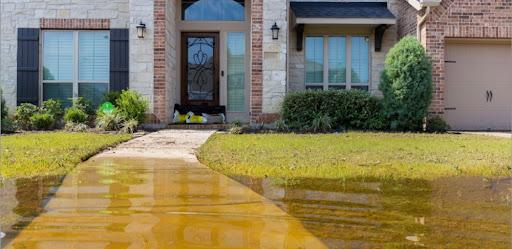When it rains, some rainfall soaks into the ground and some may run across the land’s surface. Where there are large areas of impervious surfaces such as rooftops, patios, sidewalks, roads, and parking lots, less open ground is available for the rainwater to soak into. The amount and speed of the runoff across the surface increases and is often referred to as stormwater runoff.
Water naturally flows from higher to lower land and when land use changes, such as for new home construction, a building addition, or landscaping, stormwater runoff can increase or be diverted to places it did not flow before. It is not uncommon for homeowners to try solving stormwater runoff issues by digging small trenches, extending downspouts, blocking pipes, or filling drainage ditches. These actions can, unfortunately, make a stormwater situation worse for adjacent landowners.
Identifying a Stormwater Problem
In Maryland, upstream landowners cannot increase the stormwater flow onto downstream landowners, and downstream landowners cannot block the natural flow from upstream areas. Rather than seek a hasty solution to the problem, as a rule-of-thumb, a property owner should allow ponded water to soak in for 24 to 36 hours unless there is actual damage such as flooding inside a building, erosion around a foundation, or water overtopping a driveway or patio that did not exist before. As long as the stormwater problem is not an immediate threat to life or property, there are simple steps you can take to better understand the problem and the options available to solve the issue.
- Communication: Talk to your neighbor as soon as you think there is a problem. If you do not know them, introduce yourself and explain what is going on. They may be unaware of the problem and would be willing to fix it.
- Documentation: Take photographs and videos and make notes about the stormwater flooding as it occurs. This may be helpful when dealing with your insurance company or talking to a land use agency about the situation.
- Learn about your rights and responsibilities: Find out if the County issued building or grading permits. Is there a drainage easement on your property and is water allowed to flow there legally? You can check for that information on the record plat or in homeowners’ association documents.
- Technical assistance: There are ways to reach resolution to your stormwater issue with technical assistance from private contractors or local non-profits such as the Watershed Stewards Academy.
Communication
If a neighbor created a flooding issue by improperly redirecting gutter downspouts or blocking a drainage pipe, you can often solve the problem by simple, one-on-one communication. If direct communication with your neighbor fails, consider seeking assistance from a professional mediator. Mediation is an optional, no-cost to low-cost process through which a neutral third party, a mediator, assists in discussion and negotiations between the conflicting parties.
- Anne Arundel Conflict Resolution Center, phone: 410-266-9033
- Community Mediation Maryland (CMM), 301-270-9700
- Center for Dispute Resolution, University of Maryland School of Law, 410-706-3143
- Maryland Agricultural Conflict Resolution Service (ACReS), 410-841-5700

